The Department of Public Works (DPW) undertakes the massive task of building, maintaining, and cleaning up Black Rock City. The city occupies over 4 square miles. Its facilities are assembled from 200 lampposts, 2,000 street signs, over 6,000 t-stakes, several thousand concrete form stakes, and 12 miles of fence. It encompasses an airport, banks of port-a-potties, several temporary buildings, acres of shade structure, 24 burn platforms, and 200 burn barrels. The construction of this metropolis requires thousands of hours of labor by hundreds of dedicated workers, all accomplished in a month’s time, in very harsh high-desert conditions a hundred miles from the nearest source of building supplies. Transportation, food service, sanitation, material acquisition, living quarters, fuel, and equipment maintenance are just some of the tasks to be managed. Logistics alone can be a daunting challenge.
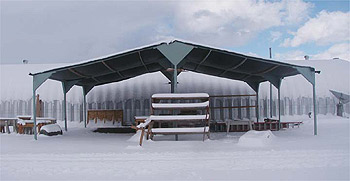
In January, the DPW management team reorganized, adding new members in the process, and DPW created a new accounting department and business process . We held meetings every week in San Francisco until March, and the early crew was ready to commence operations by spring. An improved volunteer process brought in more committed and skilled workers than ever before. Overall, the operations management plan functioned beautifully this year. Failures only engendered new successes. Better business management helped to improve our job tracking and budgeting, resulting in better control of the vital flow of money. DPW staff are already at work creating an improved plan for 2002.
DPW completed every assigned task on time in 2001, including the installation of fences, shade structures, temporary buildings, the Man and tower, the café, signage, portable toilets, communication towers, kiosks, an airport, the workers’ commissary, and the supply depot. One particular success was the burn platforms and fire barrels, which substantially mitigated burn scars on the playa. Three years ago clean-up crews repaired hundreds of burn scars on the playa This year the burn platforms and fire barrels, along with increased awareness of the issue among participants, reduced these scars to fewer than 30.
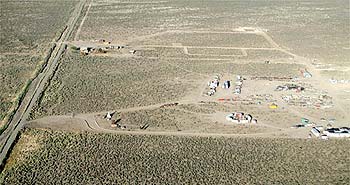
The Work Ranch
New and special challenges emerged in 2001. In addition to the normal work building Black Rock City, DPW launched an ambitious plan to develop a better base of operations. Those operations are centered at the Work Ranch, a leased property located in Hualapai Valley about 13 miles from the present location of Black Rock City and adjacent to the Fly Ranch (where Black Rock City was located in 1997). DPW was founded here in 1997 with a tent, three people, and a vision for the future.
The Work Ranch accommodates all trailers, vehicles, mobile homes, storage containers, travel trailers, camping equipment, building materials, art materials, and many other things during the 11 months of the year when Black Rock City has no physical presence. Eighty acres of flotsam from the city’s present and past have washed up on the “Eighty Acres,” along with facilities for fabricating much of our city’s infrastructure. Operations in Nevada have become increasingly important because the Bureau of Land Management (BLM) has squeezed the time that Burning Man workers can occupy the city site both before and after event.
At the peak of the work season in August over 200 DPW workers inhabit the Work Ranch. In 2001, activity at the Ranch started in March when work began on an adjacent property, Black Rock Station. Morning meetings were held at the ranch every day for the next 8 months through the completion of clean-up. Fourteen DPW staff members began working on Black Rock Station on March 15, and this work continued until August 1 when construction of Black Rock City began.
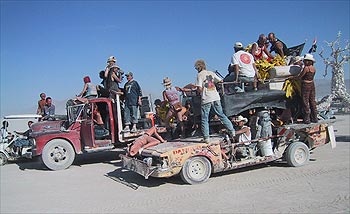
Black Rock Station
The Work Ranch has no water supply on site. In the past we were able to obtain water at no cost from property owned by Burning Man’s benevolent landlord. Potable water is essential to life on the Work Ranch, and water is also needed for dust abatement on the playa. DPW has used several million gallons each year watering the roads of Black Rock City. However, a new owner purchased the adjacent property in January and proposed to sell the water we had previously received for free at the rate of seven cents per gallon. Water was turning to gold in the desert and we didn’t have any of either. We checked all possible sources, but water is a very rare commodity in the Great Basin. Prices reflect whatever local markets will bear.
A partial solution emerged when the abandoned property immediately adjacent to the Work Ranch came up for sale, including a good well. While it was not a well of the commercial class, it could solve the immediate problem of supplying water for drinking, bathing, and local irrigation. Black Rock City LLC purchased this tract in February and our thirst for water was partially slaked. Black Rock Station, as we call it, is 200 acres of high-desert brush with an old ranch house, some outbuildings, and many future possibilities.
In March DPW undertook several projects to improve this new property, beginning by gathering up and trucking away accumulated debris. Roads were established connecting the two properties and surfaced with gravel to minimize the ever-present dust. A 4,000 square foot shop building was constructed of corrugated steel. A power system based on alternative energy was installed (solar panels and wind generator, with back-up diesel generator). The ranch house was renovated as stylish office space, including a small network and much-needed Starband satellite DSL internet connection.A pump house was built around the wellhead. A water distribution system was begun to feed a forthcoming garden and grove of trees. Primitive showers with hot and cold running water were constructed. Communications systems were upgraded.
Our principal concern was to improve living arrangements for the volunteers and workers, who labor long in harsh conditions. Increased comfort for workers improves the effectiveness of their work. Attempting to weld metal or wield a power saw in an 80 mph wind in the midst of a white-out is not an enviable chore, and some respite at the end of the workday is not too much to ask. In addition, for the first time this year, the Man was crafted in Nevada at the new shop!
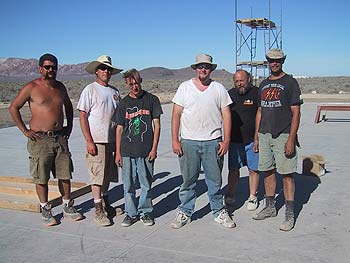
Frog Farm Ranch
The purchase of Black Rock Station supplied potable water needs, but the much greater need for water to provide dust abatement remained. Dust abatement for the roads of Black Rock City is a BLM requirement listed in the bureau’s permit stipulations. Later in the year, however, a solution presented itself when the property known as Frog Farm or Garrett Ranch (also erroneously known as Bordello Hot Springs) became available for lease. Eight artesian wells of various volumes and temperatures flow on these 320 acres, and the owner is a veteran Burning Man participant and a friend of the Project. Burning Man leased this property on very reasonable terms, including some excavating work that created new reservoirs. This project was completed in July, just in time to provide water for dust abatement.
The owner of Frog Farm also asked DPW to clean up the property and keep the public from using its hot springs. The last requirement was unacceptable, but as a compromise, all agreed that the public could walk in and bathe, but overnight camping would not be allowed.
Several new ponds now exist, including two new warm pools. After some years of absence, water fowl have begun to land there on their migratory flights, and frogs and fish are breeding in the ponds. Most of the debris has been cleared away, including some human waste. Recreational users have honored the new use restrictions with few complaints or confrontations.
Gerlach Office
The Gerlach office at 380-390 Main Street in downtown Gerlach is the communication hub for Burning Man’s Nevada operations. It provides the land phone lines not available at Black Rock Station, as well as a one-bedroom house with a laundry facility, the former Gerlach Post Office building (now converted to Burning Man offices), and the Burning Man Museum, a turn-of-the-century railroad building housing mementos and artifacts from the event’s past. The Gerlach office also functions as a retail outlet for merchandise and tickets during the summer months.This one acre of property was purchased in early 2000.
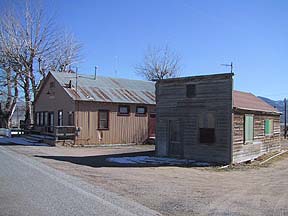
Conclusion
Burning Man and its DPW have a year-round presence in the high desert of Nevada. While DPW did a good job overall in 2001, many improvements and new directions are in prospect. Plans call for an expansion of managing staff in the coming year, and Black Rock Station should become a work center for many more Burning Man endeavors. A conference center, community center, and artist retreat are future possibilities. The Frog Farm Ranch offers additional, and more immediate, potential enhancements. The Work Ranch needs some additional improvements to accommodate a growing worker population. Many new dreams can come true for Burning Man in Nevada, and DPW is eager to help make them happen.
The Black Rock City Department of Public Works attracts a special kind of person. DPW workers face strenuous physical challenges far from the ordinary comforts of home. This high-desert country is a place of solitude and silence, quite unlike the clamor and the bustle of the temporary city overseen by the Man. Yet in many ways, the experience of working here exemplifies the essence of Burning Man. The struggle to survive in Black Rock country breeds a hardiness and sense of self-reliance. But the need to cooperate — toiling together, sharing food, and telling stories around the campfire at night — creates an intense feeling of camaraderie. Labor has a way of opening the heart. DPW workers see Black Rock City rise up out of nothing, and they witness its disappearance. But they are never spectators to this process. Our city equates, in the most immediate way imaginable, with their effort.

